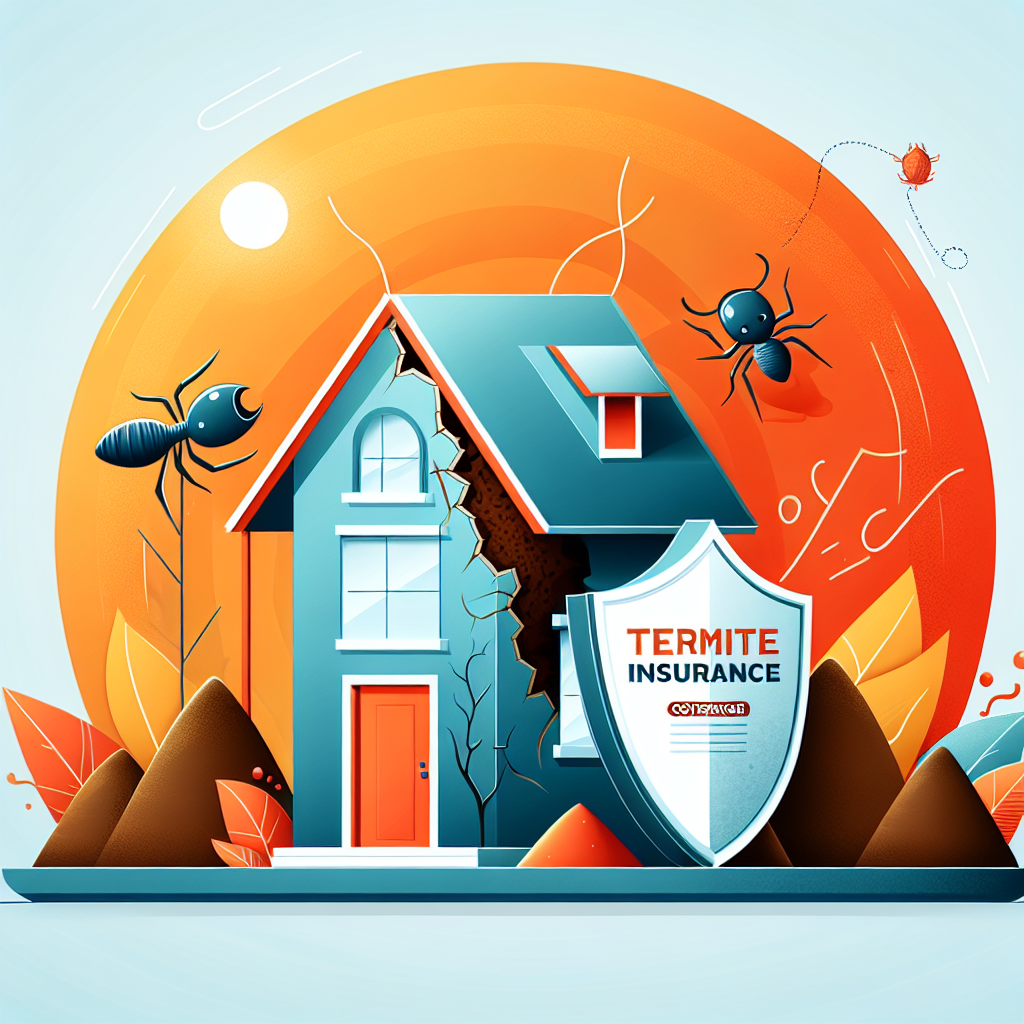Filed under Home Insurance on
Termite Coverage and Home Insurance: What's Covered

Termites don’t show up with a siren, but they can quietly chew through a home’s equity. When the damage finally surfaces, many owners assume their homeowners policy will step in. The reality is more nuanced. This guide breaks down what’s typically covered, what isn’t, and how to close the protection gap—so you can make smart, proactive decisions about Termite Coverage and Home Insurance before a small problem becomes a budget-busting repair.
Termite Coverage and Home Insurance at a glance
- Most homeowners policies exclude insect damage as a maintenance issue.
- There are narrow exceptions, like “collapse” coverage for a sudden, hidden failure caused by insects.
- Endorsements, service contracts, or termite bonds can fill coverage gaps.
- Regional termite risks and building type (single-family vs. condo) affect your best protection strategy.
Industry groups estimate termites cause more than $5 billion in property damage annually in the U.S., and most of it isn’t reimbursed by standard homeowners insurance. That’s why understanding the practical limits of Termite Coverage and Home Insurance—and the options to supplement it—is essential.
Why termites are such a big deal
Termites are wood-destroying insects that operate in silence. Subterranean termites, common in humid regions, nest in soil and feed on structural wood through mud tubes. Drywood termites, more prevalent in coastal and arid climates, colonize dry lumber and can live entirely within walls and furniture. Because they often work behind finishes, damage can accumulate for years before obvious signs appear—hollow-sounding wood, blistering paint, stuck windows, or faint clicking in walls.
By the time the damage shows, repairs can range from treating the infestation to rebuilding structural members. It’s not uncommon for major restorations to reach five figures, especially if the termites compromised load-bearing beams, floor systems, or roof trusses.
How home insurance approaches pest damage
Insurance sees termites as a maintenance risk
Homeowners insurance is designed for sudden and accidental events—think fire, windstorm, hail, or burst pipes. Termites, like rot and wear-and-tear, are classified as gradual deterioration. Because prevention and upkeep can control these risks, most insurers exclude loss caused by insects, vermin, and rodents. The logic: routine maintenance (inspections, moisture control, and treatments) should prevent or minimize this type of damage.
Two key policy frameworks
- Named-perils policies cover only the perils listed in the contract. Insect damage rarely appears on that list.
- Open-perils (all-risk) policies cover everything except exclusions. Insects and vermin are typically excluded.
Whether your policy is HO-3, HO-5, or a landlord form, you’ll almost always see exclusions for insects. However, a few carve-outs can still matter for homeowners evaluating Termite Coverage and Home Insurance.
What’s usually covered (and when)
Sudden “collapse” due to hidden insect damage
Many policies include an additional coverage for “collapse.” While definitions vary by insurer, this benefit often applies when part of a building suddenly falls down or caves in. Critically, the list of covered causes can include hidden insect or vermin damage—provided the damage was not known to the insured and the collapse is abrupt. This does not cover gradual sagging, bowing, or settling; insurers usually require a distinct, sudden failure.
Example: A porch roof abruptly caves in after hidden termite damage undermined a beam. The resulting collapse may be covered under the policy’s collapse provision, even though termite damage itself is generally excluded. Demolition and rebuilding of the collapsed portion could be paid, while the cost to treat termites or replace other non-collapsed but infested wood usually remains excluded.
Ensuing loss from a covered peril
Policies often exclude insects but cover loss caused by a separate, covered peril that ensues. If a covered peril follows the termite activity, that ensuing damage might be reimbursed.
- A termite-damaged wire arcs and starts a fire: Fire damage is typically covered.
- Termite-compromised plumbing fails, causing sudden water damage: The water damage may be covered, even though the underlying insect damage is not.
This distinction matters. It won’t pay to repair termite-gnawed studs, but it may pay for the resulting fire or water restoration.
What’s not covered (in most policies)
- Direct damage from insects or vermin, including termites
- Cost to treat or eradicate a termite infestation
- Gradual deterioration, rot, or wear-and-tear
- Damage known to the insured but not addressed (neglect)
- Cosmetic or non-structural issues not caused by a covered peril
Insurers treat termite control like lawn care, roof maintenance, or repainting—necessary upkeep to preserve a property’s condition. This is the core reason many homeowners are surprised when Termite Coverage and Home Insurance doesn’t respond to an infestation.
The fine print that can change your outcome
Endorsements that add back limited coverage
Some carriers, especially regionals in high-risk states, offer optional endorsements that provide limited coverage for insect or rodent damage (e.g., a small sublimit for repairs, often a few thousand dollars, sometimes with a waiting period). These riders are not common, but they exist. If you live in a high-activity region, ask your agent whether your insurer offers an insect damage endorsement. It can be a meaningful supplement to Termite Coverage and Home Insurance, especially for condos or smaller structures where potential repair costs are more contained.
HO-6 condos and master policies
Condo owners rely on two policies: the association’s master policy (covering common elements and, depending on the form, building exteriors) and the unit owner’s HO-6 policy (covering interior finishes and personal property). Associations sometimes maintain pest control for common areas and structural components. If termites originate in a common wall and damage your unit, the association may have responsibilities under bylaws—but that doesn’t guarantee insurance coverage. Clarify who maintains pest treatment, how damages are assessed, and whether an insect clause exists in association documents. This is one of the most overlooked angles in Termite Coverage and Home Insurance for shared buildings.
Landlords and short-term rentals
Rental policies (DP forms) also typically exclude insect damage. Landlords may have contractual obligations for pest control—especially with multiunit dwellings—and habitability rules can apply. If you rent your home (long-term or short-term), synchronize your lease language, inspection schedule, and pest service plan with your policy’s exclusions.
How to fill the coverage gap
Termite bonds and service plans
Professional termite contracts, often called bonds, provide routine inspections, treatment, and sometimes a repair guarantee. Programs vary:
- Retreatment-only: The company will re-treat if termites return, but no repair coverage.
- Repair bonds: In addition to re-treatment, the provider pays for certain repairs caused by new termite activity, subject to limits, exclusions, and inspections.
- Monitoring and baiting systems: Continuous monitoring with bait stations and scheduled inspections.
Annual costs often range from a few hundred dollars to $1,000+ for larger or complex homes. In high-risk areas, a robust bond is often the most practical complement to Termite Coverage and Home Insurance.
Home warranties and service contracts
Some home warranty companies offer limited pest add-ons, typically focused on treatment rather than structural repairs. Read terms carefully—coverage caps can be low, and pre-existing infestations are usually excluded.
Builder warranties and new construction
New homes sometimes come with a builder’s warranty or pretreatment certificate. These documents may include a term-limited promise to re-treat or repair specific termite damage, especially if soil termiticides were applied at construction. Keep these records; they can be valuable if issues emerge in the early years of ownership.
Prevention strategies that insurers (and buyers) respect
- Control moisture: Fix leaks promptly, vent crawlspaces, maintain gutters, and direct downspouts away from the foundation.
- Create a visible gap: Keep soil and mulch a few inches below siding. Avoid wood-to-soil contact.
- Store smart: Keep firewood, cardboard, and lumber off the ground and away from the house.
- Seal entry points: Caulk gaps around utilities; screen crawlspace vents; install door sweeps.
- Trim landscaping: Maintain clearance between shrubs/trees and the structure.
- Schedule inspections: Annual professional inspections catch early activity; document findings.
- Use bait or monitoring systems: Particularly effective for subterranean termites in high-activity regions.
Buyers increasingly request wood-destroying organism (WDO) inspections. Keeping a paper trail of treatments and clean reports supports resale value—and it shows diligence if any claim scenario touches collapse or ensuing loss.
Regional realities and lender requirements
Termites thrive where warmth and moisture are abundant—think the Southeast, Gulf Coast, and parts of California. Drywood species are common in coastal and desert climates, while subterranean termites are prevalent across much of the country. If you’re in a high-incidence zone, lenders or government-backed loans may require pest inspections as part of underwriting. VA and FHA loans often call for WDO inspections in designated areas or when evidence suggests a risk.
These inspections don’t change the terms of your homeowners policy, but they offer leverage to negotiate repairs, treatments, or seller credits before closing—and they spotlight the need to supplement Termite Coverage and Home Insurance with a bond or service plan from day one.
What does treatment and damage actually cost?
- Inspections: Often free or modestly priced, depending on provider and region.
- Local treatments/bait systems: A few hundred to a few thousand dollars, depending on scope.
- Whole-structure fumigation (for drywood termites): Typically a few thousand dollars, more for larger homes.
- Structural repairs: Ranges widely—minor sill plate replacement might be low four figures; extensive framing repair can exceed $10,000–$30,000.
Because termite damage can be progressive, early detection and intervention drastically reduce costs. From a financial planning perspective, many homeowners treat a termite bond as a predictable annual expense, much like HVAC maintenance, to complement Termite Coverage and Home Insurance.
Claims playbook for edge cases
Even though direct termite damage is excluded, a few situations warrant a claim or at least a conversation with your agent:
- Document everything: Photograph damage, capture dates, and keep inspection reports.
- Assess for “collapse”: If part of your structure suddenly fell down or caved in, check your policy’s collapse language.
- Look for ensuing loss: Did the termite damage lead to a distinct covered peril such as fire or sudden water discharge?
- Consult professionals: A structural engineer or licensed contractor can clarify whether the event was sudden or progressive.
- Don’t rush repairs: If you suspect a covered event, allow the insurer to inspect before making permanent fixes.
- Ask about endorsements: If you have an insect damage rider, review its sublimits and claim process.
This disciplined approach won’t convert an excluded loss into a covered one, but it ensures you capture any narrow coverage that does apply under Termite Coverage and Home Insurance.
Emerging trends to watch
- Smart monitoring: Some pest companies now offer digital bait stations and analytics for earlier detection.
- Integrated pest management (IPM): A blend of mechanical, chemical, and environmental controls to reduce reliance on heavy treatments.
- Targeted endorsements: A small but growing number of insurers pilot limited insect/rodent coverage riders in high-risk markets.
- Real estate integration: WDO inspections are increasingly standard in competitive markets, with buyers using results to negotiate credits or repairs.
Together, these shifts make it easier to pair preventive practices with the constraints of Termite Coverage and Home Insurance.
Practical checklist for homeowners
- Read your policy: Locate exclusions for insects/vermin and the additional coverage for collapse.
- Ask your agent: Do you offer an endorsement for insect damage? What are the limits and deductibles?
- Schedule a WDO inspection: Especially if it’s been more than a year since your last one.
- Address moisture: Fix leaks, improve drainage, and ventilate crawlspaces.
- Set up monitoring: Install bait systems or a professional monitoring plan.
- Consider a repair bond: In high-risk zones, weigh the cost of a bond with repair coverage.
- Document everything: Keep records of inspections, treatments, and repairs for future claims or sale.
Real-world scenarios
A sudden porch collapse
After heavy rains, a homeowner’s porch roof drops several inches. An inspection reveals hidden termite damage weakened a beam. The insurer denies termite repairs but pays for the covered “collapse” portion to rebuild the porch structure. The homeowner covers termite treatment and any non-collapsed infested components. This is a classic example of how Termite Coverage and Home Insurance may respond narrowly within the collapse provision.
A small kitchen leak becomes a big mess
A slow-leaking sink line softened the cabinet base. Termites moved in and gnawed adjacent studs. Months later, the line fails catastrophically, flooding the kitchen. The insurer covers sudden water damage and necessary tear-out/dry-out but excludes the termite-related repairs and long-term deterioration. The owner’s termite bond addresses treatment; repairs to insect-damaged wood are out-of-pocket.
Condo common wall infestation
Termites travel through a shared wall in a townhouse community. The HOA’s pest contractor treats the exterior and common elements; unit owners must address interior repairs. The HO-6 policy excludes termite damage, so the owner relies on maintenance funds or a personal termite service plan. Clarifying HOA bylaws and bonding before purchase would have reduced surprises.
FAQs
Does homeowners insurance ever cover termite damage?
Direct insect damage is typically excluded. However, policies may cover a sudden “collapse” caused by hidden insect damage, or pay for ensuing loss if a covered peril (like fire) results from termite activity.
What’s the best way to protect my home financially?
Pair strong prevention (inspections, moisture control, monitoring) with a termite bond or service plan that includes repair coverage if available. Consider any insurer endorsements that add limited insect coverage to your policy. This provides a practical complement to Termite Coverage and Home Insurance.
Will my premium go down if I get a termite bond?
Most insurers don’t discount premiums for pest plans. The payoff is risk reduction and avoiding major repairs—not rate savings.
Are termites worse in certain states?
Yes. Warm, humid regions face higher subterranean termite activity; coastal and arid zones may deal more with drywood termites. Local pest data and extension services can identify your area’s risk level.
Is DIY treatment enough?
DIY can help for detection and small, localized issues, but structural infestations warrant professional treatment. For resale, lender requirements, and recordkeeping, professional documentation is often more persuasive.
What should I ask my insurer or agent?
- Do I have collapse coverage, and how is “collapse” defined?
- Are there any endorsements for limited insect or rodent damage?
- How does my policy treat ensuing loss (fire, sudden water) tied to termites?
- What’s the claims process if a sudden failure occurs?
Key takeaways
- Standard policies exclude direct termite damage and treatment costs.
- Collapse coverage and ensuing loss are the two main pathways to limited insurance recovery.
- Endorsements, termite bonds, and diligent maintenance close the biggest protection gaps.
- Documentation—inspections, photos, repair records—supports claims and resale value.
Understanding Termite Coverage and Home Insurance isn’t just an academic exercise; it’s the difference between a manageable project and an unexpected financial hit. Use your policy’s collapse and ensuing loss provisions where they apply, but build your primary defense around prevention, monitoring, and a strong termite service plan. With the right mix of maintenance and coverage, you can protect your home’s structure—and your long-term budget—from an insect that never takes a day off.
If you’re buying, refinancing, or updating your policy, bring Termite Coverage and Home Insurance into the conversation with your agent. Confirm exclusions, explore available endorsements, and price out a bond with repair coverage. A few proactive steps today can prevent a costly surprise down the road.





